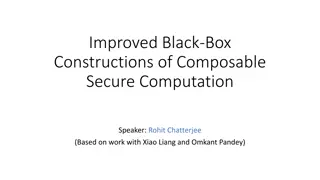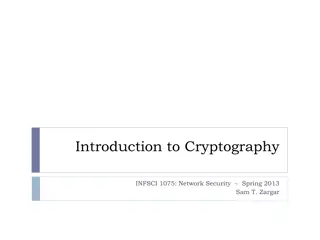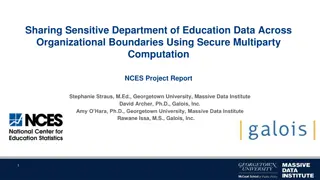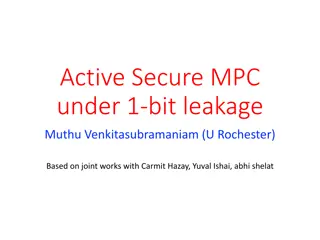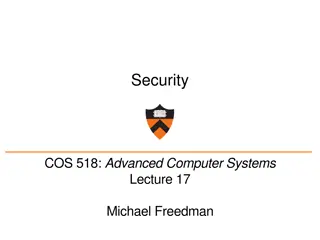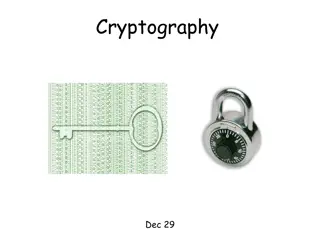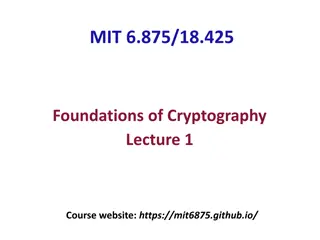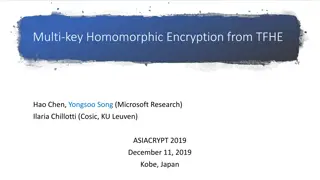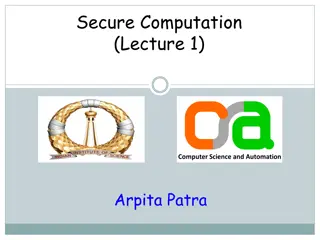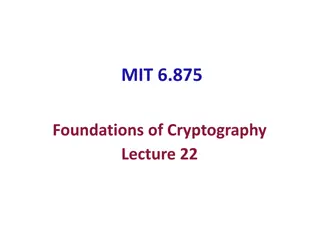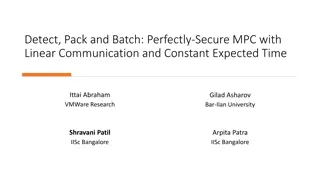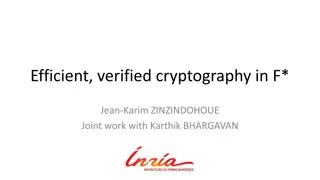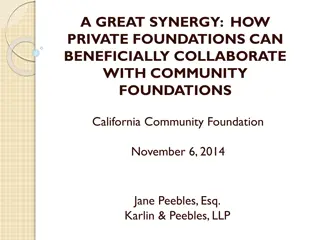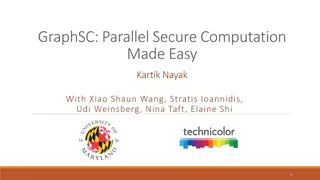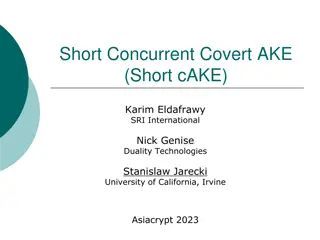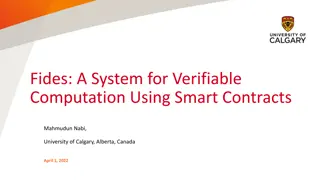Foundations of Cryptography: Secure Multiparty Computation
Explore the foundations of cryptography with insights into secure multiparty computation, including the Secure 2PC from OT Theorem and the Two-Party Impossibility Theorem. Delve into the impossibility of 2-Party Secure MPC, claims, and exercises on extending to statistical security. Learn about reducing corrupt parties and introducing cryptographic assumptions for enhanced security.
- Cryptography
- Secure Computation
- Multiparty Computation
- Cryptographic Assumptions
- Two-Party Impossibility
Uploaded on Oct 02, 2024 | 0 Views
Download Presentation

Please find below an Image/Link to download the presentation.
The content on the website is provided AS IS for your information and personal use only. It may not be sold, licensed, or shared on other websites without obtaining consent from the author. Download presentation by click this link. If you encounter any issues during the download, it is possible that the publisher has removed the file from their server.
E N D
Presentation Transcript
MIT 6.875 Foundations of Cryptography Lecture 19
Secure 2PC from OT Theorem [Goldreich-Micali-Wigderson 87]: Assuming OT exists, there is a protocol that solves any two-party computation problem against semi-honest adversaries.
Two-Party Impossibility Theorem (folklore): There is no perfectly / statistically secure two- party protocol for computing the AND function.
Impossibility of 2-Party Secure MPC (due to Rotem Oshman) Alice: ? 0,1 , Bob: ? 0,1 Goal: compute ? ? No information-theoretically secure implementation! Fix any protocol Let ??,?? = probability of transcript ? on input ?,? w.l.o.g, the transcript contains ? ?
Impossibility of 2-Party Secure MPC Claim: ??,?? = ? ?,? ? ?,? for some ?,? Proof: ? ??,?? = Pr ?? is sent | ?? 1, ,?1,?,? ?=1 = Pr ?? is sent | ?? 1, ,?1,?,? ? ?,? ?:Alice speaks Pr ?? is sent | ?? 1, ,?1,?,? ? ?,? ?:Bob speaks
Impossibility of 2-Party Secure MPC Claim: ??,?? = ? ?,? ? ?,? for some ?,? From (perfect) security: for every ?, ?1,0? = ?0,0? = ?0,1? ? 1,? ? 0,? = ? 0,? ? 0,? = ? 0,? ? 1,? ? 0,? = ? 1,? and ? 0,? = ? 1,? But then, ?1,1? = ? 1,? ? 1,? = ? 0,? ? 0,? = ?0,0? The protocol is incorrect!
Extend to statistical security? Exercise.
Where to Go From Here? Option 1: reduce the number of corrupt parties Option 2: introduce cryptographic assumptions
Secure 2PC from OT Theorem [Goldreich-Micali-Wigderson 87]: Assuming OT exists, there is a protocol that solves any two-party computation problem against semi-honest adversaries.
How to Compute Arbitrary Functions For us, programs = functions = Boolean circuits with XOR (+ ??? 2) and AND ( ??? 2) gates. ??(? + ? ) X ? + ? ?? + X ? ? ? ? Want: If you can compute XOR and AND in the appropriate sense, you can compute everything.
Recap: OT Secret-Shared-AND Alice gets random ?, Bob gets random ? s.t. ? ? =ab. ? {0,1} ? {0,1} Output: ? Output: ? Run an OT protocol ?0= ? ?1= ? ? Choice bit ? Alice outputs ?. Bob gets ??? + ??? ? = (?? ??)? + ??= ?? ? ?
How to Compute Arbitrary Functions Secret-sharing Invariant: For each wire of the circuit, Alice and Bob each have a bit whose XOR is the value at the wire. XOR gate: Locally XOR the shares AND gate?? X ? ? + X ? 0 ? 0 0 ? 0 ? Base Case: Input wires
Recap: XOR gate ? ? Alice has ? and Bob has ? s.t. + ? ? = ? ? ? Alice has ? and Bob has ? s.t. ? ? = ? Alice computes ? ? and Bob computes ? ? . So, we have: (? ? ) ? ? = ? ? ? ? = x x
AND gate ?? Alice has ? and Bob has ? s.t. X ? ? = ? ? ? Alice has ? and Bob has ? s.t. ? ? = ? Desired output (to maintain invariant): Alice wants ? and Bob wants ? s.t. ? ? = ??
AND gate ?? ?? = (? ?)(? ? ) X = ?? ?? ?? ?? ?? ?? ?? ? ? ?? ? ? ? ? ss-AND ss-AND ?? ?? ?? ?? ? = ?? ?? ?? ? = ?? ?? ??
How to Compute Arbitrary Functions Secret-sharing Invariant: For each wire of the circuit, Alice and Bob each have a bit whose XOR is the value at the wire. Finally, Alice and Bob exchange the shares at the output wire, and XOR the shares together to obtain the output. ? ? ? = ??(? ? ) ? X + X ? ? ? ?
Security by Composition Theorem: If protocol securely realizes a function ? in the ?-hybrid model and protocol securely realizes ?, then securely realizes ?. ?-angel + Protocol for ? in the ?-hybrid model Protocol for ?
Security: Intuition (ss-AND hybrid model) Imagine that the parties have access to an ss-AND angel. ? ? =ab
Security: Intuition (ss-AND hybrid model) Imagine that the parties have access to an ss-AND angel. Simulator for Alice s view: XOR gate: simulate given Alice s input shares X ? ? + X ? 0 ? 0 0 ? ? 0 Input wires: can be simulated given Alice s input
Security: Intuition (ss-AND hybrid model) Simulator for Alice s view: AND gate: simulate given Alice s input shares & outputs from the ss-AND angel. Alice s share = ? 0 + ????? ?,? + ?????(0,0) ?????? X ? ? ?????? + X ? 0 ? 0 0 ? ? 0 ?????? and ?????? are random, independent of ?
Security: Intuition (ss-AND hybrid model) Simulator for Alice s view: Output wire: need to know both Alice and Bob s output shares. Bob s outputshare = Alice s output share function output X ? ? Simulator knows the function output, and can compute Bob s output share given Alice s output share. + X ? 0 ? 0 0 ? ? 0
Secret-Shared AND protocol Using the RSA trapdoor permutation. Input bit: a Input bit: ? Pick ? = ?? and RSA exponent ?. ?,? Choose random ?? and set ??= ?? Choose random ?1 ? ? mod ? Let ?0 be random and ?1= ?0 a. ?0,?1 Compute ?0,?1 and one-time pad ?0,?1 using hardcore bits ?0 ??? ?0 ?1 ??? ?1 Alice outputs ?0 Bob outputs ??
Secret-Shared AND protocol Using the RSA trapdoor permutation. Input bit: a Input bit: ? Exercise: Construct simulators for Alice and Bob.
In summary: Secure 2PC from OT Theorem [Goldreich-Micali-Wigderson 87]: Assuming OT exists, there is a protocol that solves any two-party computation problem against semi-honest adversaries.
In fact, GMW does more: Theorem [Goldreich-Micali-Wigderson 87]: Assuming OT exists, there is a protocol that solves any multi-party computation problem against semi-honest adversaries.
MPC Outline Secret-sharing Invariant: For each wire of the circuit, the n parties have a bit each, whose XOR is the value at the wire. Base case: input wires. ? XOR gate: given input shares ?1, ,?? s.t. ?=1 and ?1, ,?? s.t. ?=1 output of the XOR gate: ?1+ ?1, ,??+ ?? ??= ? ? ??= ?, compute the shares of the AND gate: given input shares as above, compute the shares of the output of the XOR gate: ? ?1, ,?? s.t ?=1 ??= ?? Exercise!
Security against Malicious (Active) Adversaries
Secure Two-Party Comp: New Def (possibly randomized) ? ?,?;? = (???,?;? ,??(?,?;?)) Input: ? Input: ? Alice Bob There exists a PPT simulator ???? such that for any ? and ?: (?????,???,? ,?(?,?)) (?????(?,?),?(?,?)) i.e. the joint distribution of the view and the output is correct
Counterexample Randomized functionality ? 1?,1?= (?, ). Protocol: Alice picks a random ?, outputs it and sends it to Bob. Is this secure? Secure acc. to old def, insecure acc. to new def. Ergo, old def is insufficient.
Malicious Parties: Issues to Handle 1. Input (In)dependence: A malicious Alice could choose her input to depend on Bob s, something she cannot do in the ideal world. Example: ? ?,? ,? = ( ,?? + ?) 2. Randomness: A malicious Bob could choose his random string in the protocol the way she wants, something she cannot do in the ideal world. Example: our ?? protocol unavoidable 3. (Un)fairness: A malicious party could block the honest party from learning the output, while learning it herself. 4. Deviate from Other Protocol Instructions.
The GMW Compiler Theorem [Goldreich-Micali-Wigderson 87]: Assuming one-way functions exist, there is a general way to transform any semi-honest secure protocol computing a (possibly randomized) function F into a maliciously secure protocol for F.
Input Independence 1. Input (In)dependence: A malicious party could choose her input to depend on Bob s, something she cannot do in the ideal world. Solution: Each party commits to their input in sequence, and provides a zero-knowledge proof of knowledge of the underlying input.
Solution: Coin-Tossing Protocol 2. Randomness: A malicious party could choose her random string in the protocol the way she wants, something she cannot do in the ideal world. Def: Realize the functionality ? 1?,1?= (?,???(?)). ???(?1) ?2 Output? = ?1 ?2 Output(??? ?1,?2)
Zero Knowledge Proofs 4. Deviate from Other Protocol Instructions. Solution: Each message of each party is a deterministic function of their input, their random coins and messages from party B. When party A sends a message ? = ?(??,??,????), they also prove in zero-knowledge that they did so correctly. That is, they prove in ZK the following NP statement: ?,????,????,???? : ??,?? s.t. ? = ? ??,??,???? ???? = Com ?? ???? = Com ??
Optimization 1: Preprocessing OTs Random OT tuple (or AND tuple, or Beaver tuple after D. Beaver): Alice has (?,??) and Bob has (?,??) which are random s.t. ?? ??= ??. Theorem: Given O(1) many random OT tuples, we can do OT with information-theoretic security, exchanging O(1) bits.
Optimization 2: OT Extension Theorem [Beaver 96, Ishai-Kushilevitz-Nissim-Pinkas 03]: Given O(?) many random OT tuples, we can generate ? OT tuples exchanging O(?) bits --- as opposed to the trivial O(??) bits --- and using only symmetric-key crypto.
Complexity of the 2-party solution Number of OT protocol invocations = 2 #??? gates Can be made into O(#inputs ?): Yao s garbled circuits Number of rounds = AND-depth of the circuit Can be made into O(1) rounds: Yao s garbled circuits Communication in bits = ?(#??? ? + #???????) Can be made into O(? #inputs) using FHE: but FHE is computationally more expensive concretely.




